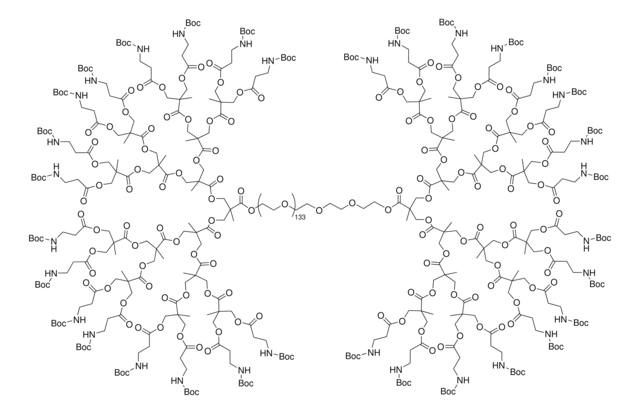Z514039
Dendrimers and other Dendritic Polymers
Anmeldenzur Ansicht organisationsspezifischer und vertraglich vereinbarter Preise
Alle Fotos(1)
About This Item
ISBN-10:
0471638501
ISBN-13:
978-047163850-6
UNSPSC-Code:
55101509
Empfohlene Produkte
Informationen zur Veröffentlichung
J. Frechet and D. Tomalia, John Wiley & Sons, 2002, 688 pp., hard cover
Allgemeine Beschreibung
Provides a detailed insight into dendritic polymers, and discusses all the known subclasses of dendritic polymers in addition to dendrons and dendrimers, including hyperbranched polymers, dendrigrafts and megamers. With contributions from many of the leading scientists in the field of dendritic polymers, this comprehensive volume provides an overview of developments in the field of dendrimers, with a comparison of properties and synthesis to traditional polymers. Also includes a discussion of commercial and potential applications for dendritic polymers, an identification of the key trends and analytical perspectives in dendrimer research , and practical procedures for the laboratory preparation of some of the more commonly used dendrimer families. This will be essential reading for all chemists, polymer/material scientists, plastics engineers, nanotechnologists and postgraduate polymer scientists and engineers.
Inhaltsverzeichnis
I Introduction and Progress in the Control of Macromolecular Architecture
Introduction to the Dendritic State
Structure Control of Linear Macromolecules
Progress in the Branched Architectural State
Developments in the Accelerated Convergent Synthesis of Dendrimers
Formation, Structure and Properties of the Crosslinked State Relative to Precursor Architecture
Regioselectively-Crosslinked Nanostructures
Hybridization of Architectural States: Dendritic-linear Copolymer Hybrids
Statistically Branched Dendritic Polymers
Semi-Controlled Dendritic Structure Synthesis
II Characterization of Dendritic Polymers
Gel Electrophoretic Characterization of Dendritic Polymers
Characterization of Dendritically Branched Polymers by Small Angle Neutron Scattering (SANS), Small Angle x-ray Scattering (SAXS), and Transmission Electron Microscopy (TEM)
Atomic Force Microscopy for the Characterization of Dendritic Polymers and Assemblies
Characterization of Dendrimer Structures by Spectroscopic Techniques
Rheology and Solution Properties of Dendrimers
III Properties and Applications of Dendritic Polymers
Dendritic and Hyperbranched Glycoconjugates as Biomedical Anti-Adhesion Agents
Some Unique Features of Dendrimers based upon Self-assembly and Host-Guest Properties
Dendritic Polymers: Optical and Photchemical Properties
Bioapplications of PAMAM Dendrimers
Dendrimer-Based Biological Reagents: Preparation And Applications in Diagnostics
Dendritic Polymer Applications: Catalysts
Optical Effects Manifested by PAMAM Dendrimer Metal Nano-Composites
Dendrimers in Nanobiological Devices
Antibodies to PAMAM dendrimers: Reagents for immune detection, patterning and assembly of Dendrimers
IV Laboratory Preparation of Dendrimers and Conclusion
Preparation of ′Frechet-type′ Polyether Dendrons and Aliphatic Polyester Dendrimers by Convergent Growth: an experimental primer
Laboratory Synthesis of Poly(amidoamine) (PAMAM) Dendrimers)
Synthesis and Characterization of Poly(Propylene imine) Dendrimers
Laboratory Synthesis and Characterization of Megamers
Conclusion/Outlook - Toward Higher Macromolecular Complexity in the Twenty-first Century
Introduction to the Dendritic State
Structure Control of Linear Macromolecules
Progress in the Branched Architectural State
Developments in the Accelerated Convergent Synthesis of Dendrimers
Formation, Structure and Properties of the Crosslinked State Relative to Precursor Architecture
Regioselectively-Crosslinked Nanostructures
Hybridization of Architectural States: Dendritic-linear Copolymer Hybrids
Statistically Branched Dendritic Polymers
Semi-Controlled Dendritic Structure Synthesis
II Characterization of Dendritic Polymers
Gel Electrophoretic Characterization of Dendritic Polymers
Characterization of Dendritically Branched Polymers by Small Angle Neutron Scattering (SANS), Small Angle x-ray Scattering (SAXS), and Transmission Electron Microscopy (TEM)
Atomic Force Microscopy for the Characterization of Dendritic Polymers and Assemblies
Characterization of Dendrimer Structures by Spectroscopic Techniques
Rheology and Solution Properties of Dendrimers
III Properties and Applications of Dendritic Polymers
Dendritic and Hyperbranched Glycoconjugates as Biomedical Anti-Adhesion Agents
Some Unique Features of Dendrimers based upon Self-assembly and Host-Guest Properties
Dendritic Polymers: Optical and Photchemical Properties
Bioapplications of PAMAM Dendrimers
Dendrimer-Based Biological Reagents: Preparation And Applications in Diagnostics
Dendritic Polymer Applications: Catalysts
Optical Effects Manifested by PAMAM Dendrimer Metal Nano-Composites
Dendrimers in Nanobiological Devices
Antibodies to PAMAM dendrimers: Reagents for immune detection, patterning and assembly of Dendrimers
IV Laboratory Preparation of Dendrimers and Conclusion
Preparation of ′Frechet-type′ Polyether Dendrons and Aliphatic Polyester Dendrimers by Convergent Growth: an experimental primer
Laboratory Synthesis of Poly(amidoamine) (PAMAM) Dendrimers)
Synthesis and Characterization of Poly(Propylene imine) Dendrimers
Laboratory Synthesis and Characterization of Megamers
Conclusion/Outlook - Toward Higher Macromolecular Complexity in the Twenty-first Century
Hier finden Sie alle aktuellen Versionen:
Analysenzertifikate (COA)
Lot/Batch Number
It looks like we've run into a problem, but you can still download Certificates of Analysis from our Dokumente section.
Wenn Sie Hilfe benötigen, wenden Sie sich bitte an Kundensupport
Besitzen Sie dieses Produkt bereits?
In der Dokumentenbibliothek finden Sie die Dokumentation zu den Produkten, die Sie kürzlich erworben haben.
Unser Team von Wissenschaftlern verfügt über Erfahrung in allen Forschungsbereichen einschließlich Life Science, Materialwissenschaften, chemischer Synthese, Chromatographie, Analytik und vielen mehr..
Setzen Sie sich mit dem technischen Dienst in Verbindung.




